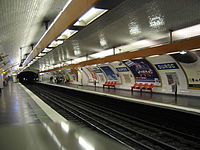|
Duroc station
Duroc (French pronunciation: [dyʁɔk]) is a station on lines 10 and 13 of the Paris Métro. It is located at the point for which the 6th, 7th and 15th arrondissements share a common border, close to the location of an old toll gate on the road to Sèvres, part of the Wall of the Ferme générale, which was built around Paris between 1784 and 1791 by the ferme générale company of tax farmers. The station is named after the nearby rue Duroc, which in turn is named after Géraud Duroc, Duke of Frioul (1772–1813), who was one of Napoleon's generals, noted for his friendship with Napoleon Bonaparte, he is sometimes referred to as ‘Napoleon's shadow’ (l'ombre de Napoléon in French). History Line 10's station was opened by the Compagnie du chemin de fer métropolitain de Paris (CMP) on 30 December 1923 as part of the first section of the Ligne circulaire intérieure (inner circular line) from Invalides (now on line 13) to Croix-Rouge (a station east of Sèvres – Babylone, which was closed during World War II). The line was planned by Fulgence Bienvenüe to connect the city's six main railway stations, with Duroc presumably intended to serve the Gare Montparnasse, although it being located 500 metres away. The project was eventually abandoned and on 27 July 1937, the section from Duroc to Invalides was transferred to become the first section of the old line 14. The section between Duroc and Croix-Rouge, by that time extended east to Jussieu remained as line 10. It extended west from Duroc to La Motte-Picquet–Grenelle on the same day. On 9 November 1976, the old line 14 was incorporated into line 13 following the latter's extension in successive phases from Saint-Lazare.  Since 2004, the station has been temporarily renamed "Durock" on the occasion of the Rock en Seine festival almost every year for a week in June. Several rock-related posters are also placed on the walls of the platforms.[1][2][3][4] As part of the "Un métro + beau" programme by the RATP, the station's corridors were renovated and modernised on 21 October 2006.[5] In 2012, platform screen doors were installed on line 13's platforms, together with eleven other stations on the line in an attempt to increase the average speed of trains and reduce track-related incidents due to the line's heavy traffic. On 6 December 2017, in a tribute to Johnny Hallyday (1963-2017), a French musician and actor who had died the night before, the station was temporarily renamed "Durock Johnny" for a day, with excerpts from his greatest hits played on the platforms.[6][7] In 2019, the station was used by 3,596,220 passengers, making it the 134th busiest of the Métro network out of 302 stations.[8] In 2020, the station was used by 1,972,711 passengers amidst the COVID-19 pandemic, making it the 124th busiest of the Métro network out of 304 stations.[9] In 2021, the station was used by 2,645,064 passengers, making it the 130th busiest of the Métro network out of 304 stations.[10] Passenger servicesAccessThe station has 4 accesses:
Station layout
PlatformsBoth lines have a standard configuration with 2 tracks surrounded by 2 side platforms. Platform screen doors are installed on line 13's platforms. Other connectionsThe station is also served by lines 28, 70, 82, 86, 89, and 92 of the RATP bus network. Nearby
Gallery
Wikimedia Commons has media related to Duroc (Paris Metro). References
|
|||||||||||||||||||||||||||||||||||||||||||||||||||||||||||||||||||||||||||||||||||||||||||







